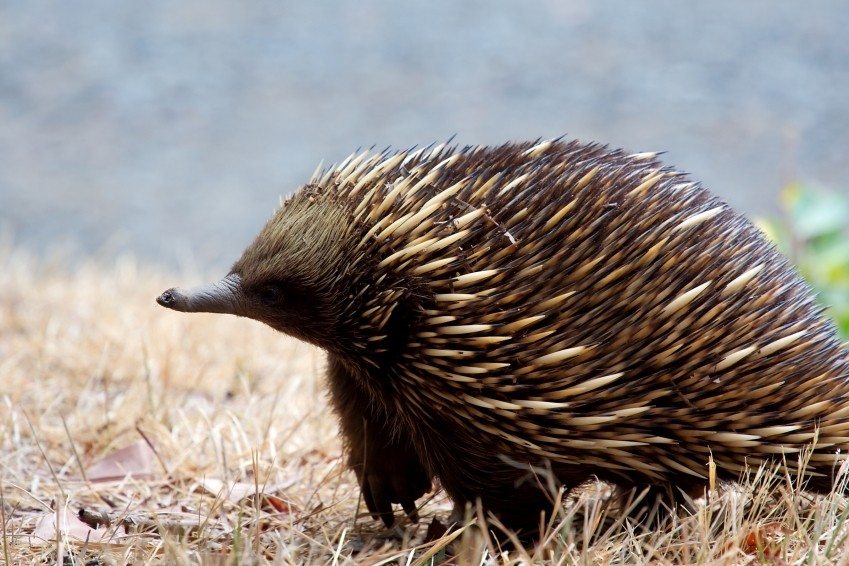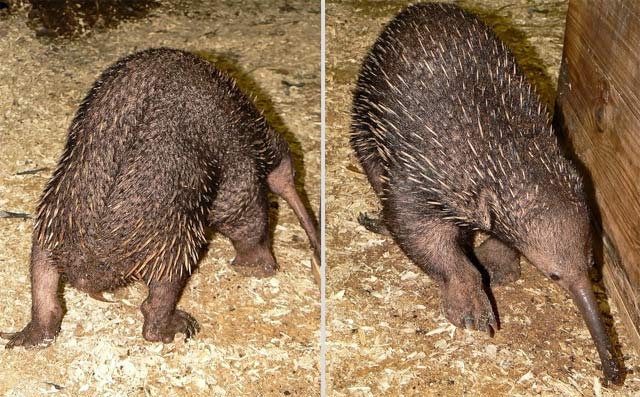The Echidna, or Spiny Anteater as it is known, looks like an oversized hedgehog with a long thin nose sticking out in front – one of nature’s weirdest creations, perhaps! Especially when you add that they are one of the only two mammals that lay eggs in a pouch! (The other is the duck-billed platypus.)
Here are 20 more interesting facts about Echidna (Australia’s version of the hedgehog):
1 – The Echidna, Tachyglossidae, is a very primitive mammal – as the egg-laying bit would indicate – and is native to New Guinea and Australia.
2 – There are four living species of Echidna, in two families, Tachyglossus and Zaglossus. The single member of Tachyglossus is T. Aculeatus (which means ‘spiny fast-tongue’), aka the short-beaked echidna while the three members of Zaglossus are Z. Bruijni, the Western long-beaked echidna, Z. Attenboroughi, Sir David’s long-beaked echidna and Z. Bartoni, the Eastern long-beaked echidna. The long-beaked echidnas are only found in New Guinea’s highlands, but the short-beaked echidnas are found anywhere in New Guinea and Australia where their food is always available.
3 – Egg-laying mammals are called ‘monotremes’, and despite their nickname of Spiny Anteater, Echidnas are not at all related to the true anteaters in America. They are thought to be fairly intelligent, perhaps around the same level as cats.
4 – The name Echidna is taken from a Greek mythological monster of the same name, although that monster was half-snake, half-woman (and apparently mother of most of the other monsters in Greek myths). One is therefore hard-pressed to work out how the name came to be applied to an egg-laying hedgehog with a long nose!
Appearance
5 – The Echidna is a small mammal with a long narrow snout, a coarse, short brown coat and cream-coloured 50 mm (2-inch) spines all over its back and sides. Each of these spines is formed from a single hair and is made of keratin, the same substance that forms toe and fingernails in humans.
6 – The snout is about 3 in (7-8 cm) long and rigid, so that it can be used to dig into rotten wood and termite mounds to find food, and it has a small mouth on the underside that contains its extremely long, sticky tongue.
7 – The monotremes are the only land-based mammals to have developed electroreception, or the ability to sense the natural electrical fields emitted by all living things through the use of electroreceptors in their snouts. Since it works much better in water, or in very damp areas on land, this ability in the Echidnas (who don’t go in water very much at all) is thought to be an evolutionary throwback and an indication that they shared an ancestor with the platypus way back when.
The long-beaked echidnas have around 2,000 electroreceptors in the snout, but the short-beaked echidna only has around 400, grouped in the extreme end (these numbers compare to the 40,000 of the platypus, who uses the ability much more since it spends a lot of its time in water).
8 – The Echidna is a solitary animal that can grow to up to 20 in (50 cm) in length, weigh between 6.5 and 14.5 lbs (2-5 kg) and live for around 45-50 years.
9 – Male echidnas, like male platypuses, have spines on their heels called spurs, but unlike the platypus, they do not have venom glands attached.
Behaviour
10 – Contrary to the indications of their nickname, not all Echidnas live exclusively on ants, termites and the likes. The short-beaked echidna does, but the long-beaked echidnas live in damp tropical forests and use their electroreceptors to search out earthworms and insect larvae.
11 – They use their strong clawed paws to break open the rotten logs, leaf mould, anthills or termite mounds they find and a long and sticky tongue to catch the ants, termites, worms and insect grubs thus flushed out. They need to eat hundreds of these little insects a day to keep themselves alive.
12 – One astonishing fact about Echidna is their ability to roll into a ball when threatened Like the hedgehog, so the spines on their backs protect them from attack. They also have long claws that they use to break into anthills, so their undersides are not exactly undefended, either. Sometimes, instead, they will ‘dig for freedom’ or hide in a log or crevice, making sure that they have their back to the opening – so that the predator is presented with an array of spines.
13 – Echidnas drink water and are able to swim. They are also very strong – they can lift up to twice their own weight if they need to move something out of their way.
Family life
14 – When Echidnas mate they do it belly to belly – otherwise it would be a rather painful experience for the male!
15 – The male has a retractable penis with four heads, and uses two heads at a time (swapping between the pairs on each occasion).
16 – The females’ single egg is laid in her pouch around two weeks after mating and hatches about ten days later. The infant ‘puggle’ (what a wonderful name!) is born blind and hairless.
17 – The puggle feeds on its mother’s milk through a gland in the pouch for two months or so, but then its spines begin to grow and, understandably, the mother insists it gets out! She then digs it a burrow and comes back every few days to suckle it until it is around seven months old and can be weaned.
Echidnas and Us
18 – The echidna is found on the back of the five-cent coin in Australia.
19 – An echidna called Millie was the mascot for the Sydney 2000 Summer Olympics.
20 – Knuckles is a red echidna that features in the ‘Sonic the Hedgehog’ video game series, first appearing in Sonic 3 (for the Sega Genesis and Sega Mega Drive).


